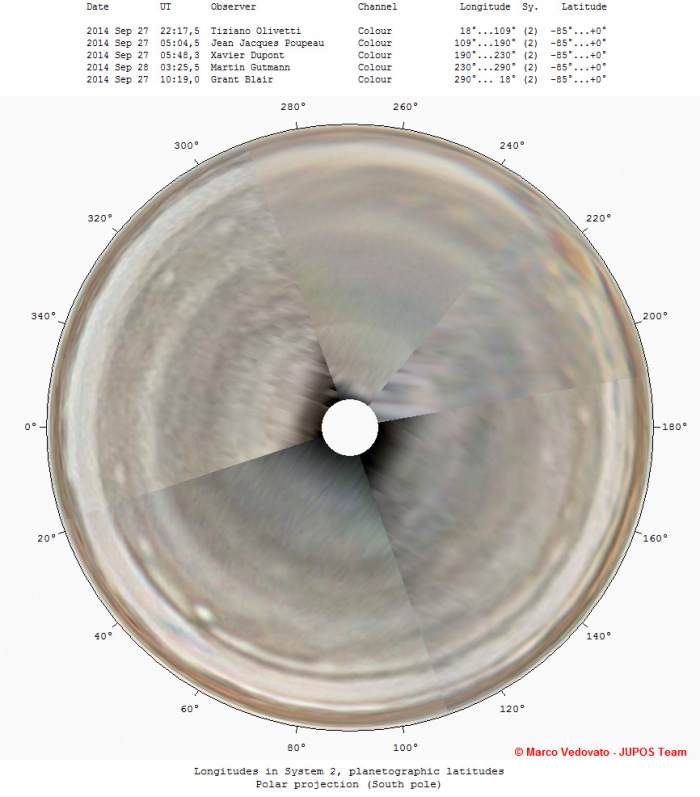Giove: mappa più recente
Da Sezione Pianeti UAI.
| Riga 17: | Riga 17: | ||
=== Remarks about some visible features === | === Remarks about some visible features === | ||
| - | ''SSTB Ovals'' - White spots at | + | ''SSTB Ovals'' - White spots at 40,5°S, long-lived anticyclonic circulations, named as A1, A2, A3 ... Their drifts lead them to overcome the GRS about once a year. |
''BA Oval'' - It is the result after the merging of three pre-existing ovals, during the year 2000. It is a large anticyclonic circulation, close to the latitude 33°S; in the year 2005 its color turned to a pale red. Its drift leads BA to overpass the GRS about every two years. | ''BA Oval'' - It is the result after the merging of three pre-existing ovals, during the year 2000. It is a large anticyclonic circulation, close to the latitude 33°S; in the year 2005 its color turned to a pale red. Its drift leads BA to overpass the GRS about every two years. | ||
Versione delle 15:31, 14 ott 2014
JUPITER: LATEST PLANISPHERES
Jupiter planispheres composed with images taken between 2014 October, 09-12
Maps prepared by Marco Vedovato with the software WinJUPOS.
Remarks about some visible features
SSTB Ovals - White spots at 40,5°S, long-lived anticyclonic circulations, named as A1, A2, A3 ... Their drifts lead them to overcome the GRS about once a year.
BA Oval - It is the result after the merging of three pre-existing ovals, during the year 2000. It is a large anticyclonic circulation, close to the latitude 33°S; in the year 2005 its color turned to a pale red. Its drift leads BA to overpass the GRS about every two years.
STB (South Tropical Belt)- Belt whose color intensity is variable as well as its latitude, variable in longitude.
GRS (Geat Red Spot) - The edge is sometimes marked by a dark ring; nowadays the inner area has a pale red color.
SEB - In questi anni la fascia è andata incontro a cicli di attenuazione, seguiti da eruzioni di attività che l'hanno riportata all'intensità solita.
EB - Periodicamente si è sviluppa una tenua fascia equatoriale; anche questo è un fenomeno periodico. La fascia poi lentamente svanisce e per riformarsi nei periodi di maggior attività del pianeta.
NEB - Questa fascia è la più scura del pianeta, attiva sia all'interno, sia ai suoi bordi. Periodicamente si espande verso nord e poi si restringe, fenomeno che si ripete con cadenza quadriennale, accompagnato dalla produzione di ovali chiari e macchie scure lungo il bordo in espansione.
WSZ (White Spot Z) - E' nata nel 1997, come una delle tante macchie bianche (anticicloniche) che appaiono a 19°N. E' caratterizzata, oltre che dalla longevità, dal moto veloce (verso longitudine decrescente), che la porta a interagire con altre macchie della sua latitudine, generalmente stazionarie nel Sistema 2. Nel mese di novembre 2013 ha assunto una debole colorazione rossastra.
NTB - Come la SEB e la NEB, è sede di periodiche eruzioni di macchie bianche e condensazioni scure, che producono velature nell'attigua zona (NTZ).
NNTB - Di aspetto variabile con la longitudine; presenta segmenti più marcati.
Piccola Macchia Rossa (LRS) in NNTZ - Poco appariscente, ma estremamente longeva: risale almeno al 1993. Si trova a 40°N, e periodicamente si colora in modo più intenso.





